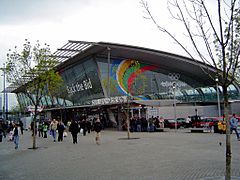Stratford station facts for kids
 |
|
| Location | Stratford |
|---|---|
| Local authority | London Borough of Newham |
| Managed by | TfL Rail London Underground |
| Station code | SRA |
| Number of platforms | 15 |
| Fare zone | 3 |
| London Underground annual entry and exit | |
| 2007 | |
| 2008 | |
| 2009 | |
| 2010 | |
| 2011 | |
| 2012 | |
| National Rail annual entry and exit | |
| 2004–05 | 7.914 million |
| 2005–06 | 7.699 million |
| 2006–07 | 13.089 million |
| 2007–08 | 11.273 million |
| 2008–09 | |
| — interchange | 1.143 million |
| 2009–10 | |
| — interchange | 1.383 million |
| 2010–11 | |
| — interchange | 1.659 million |
| 2011–12 | |
| Other information | |
| Lists of stations | |
| Other websites |
|
Stratford station is a very busy railway station in Stratford, East London. It's located in the London Borough of Newham.
This station is a major hub, meaning many different train and Tube lines meet here. You can catch National Rail trains, London Underground (the Tube), London Overground trains, and the Docklands Light Railway (DLR) from Stratford.
The Tube lines that stop here are the Central line and the Jubilee line. Other train services include London Overground, Greater Anglia, TfL Rail, and c2c. Stratford station is in Travelcard Zone 3, which is part of London's public transport fare system.
To avoid confusion with Stratford-upon-Avon (where William Shakespeare was born!), this station is officially called Stratford (London) by National Rail. Sometimes people also call it Stratford Regional to tell it apart from Stratford International station, which is only about 400 yards (370 m) away.
Contents
A Busy Transport Hub
Stratford station is one of London's most important transport places. It connects many different parts of the city and beyond. Think of it like a giant crossroads for trains and Tube lines!
What Lines Serve Stratford?
Stratford station is unique because it serves so many different types of trains and Tube lines.
London Underground (The Tube)
- Central line: This is one of the oldest and busiest Tube lines. It runs east to west through central London.
- Jubilee line: This line connects parts of East London, including the Canary Wharf business area, with central and north-west London.
National Rail Services
- Greater Anglia: These trains connect Stratford to places further east, like Essex and East Anglia.
- TfL Rail: This service runs local trains, and it's part of the new Elizabeth line (Crossrail) project.
- c2c: These trains connect London to places along the Thames Estuary in Essex.
London Overground
- The London Overground is a network of suburban rail lines that circle London. From Stratford, you can travel to other parts of East and North London.
Docklands Light Railway (DLR)
- The Docklands Light Railway (DLR) is a special automated train system. It mainly serves the Docklands area of East London, including Canary Wharf and London City Airport. The DLR trains don't have drivers!
Travelcard Zones Explained
London is divided into different "zones" for public transport. These are called Travelcard Zones. Stratford station is in Zone 3. This means that if you have a ticket or Travelcard for Zone 3, you can use it to travel to and from Stratford. The further out you travel from central London (Zone 1), the higher the zone number.
Station History and Development
Stratford station has been around for a long time and has changed a lot over the years. It first opened way back in 1839!
Key Dates in Stratford Station's History
- 1839: The station first opened its doors, built by the Eastern Counties Railway (ECR).
- 1946: The Central line of the London Underground started serving Stratford, making it easier for people to travel across London.
- 1987: The Docklands Light Railway (DLR) began operating, connecting Stratford to the developing Docklands area.
- 1999: The Jubilee line was extended to Stratford, further improving Tube connections.
- 2009: More changes and upgrades happened to make the station even better for passengers.
These changes show how important Stratford station has become as London has grown and developed.
Images for kids
See also
 In Spanish: Estación de Stratford para niños
In Spanish: Estación de Stratford para niños







